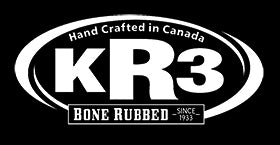
Los primeros años
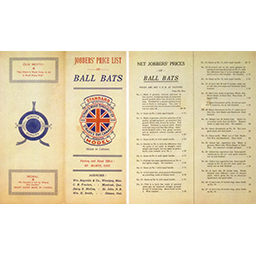
La ciudad de St. Marys Ontario está situada en el río Támesis, a unas 22 millas de Londres. Se estableció por primera vez en 1839, cuando Thomas Ingersoll, hermano de Laura Secord, construyó un molino en Little Falls para la Canada Company. En 1841-43 erigió un aserradero y un molino de molienda a cambio de tierras en los alrededores. Marys y no pasó mucho tiempo antes de que se establecieran en la zona otros negocios, como un molino de lino, un herrero, un fabricante de carruajes, un fabricante de mantequilla y queso y comerciantes al por menor. En 1854 se constituyó un pueblo. Para el año 1868 el negocio mercantil estaba bien establecido con el Almacén General de Beattie entre los principales comerciantes. En esta época, uno de los otros grandes comerciantes decidió marcharse a Toronto, donde podría perseguir mejor sus sueños de crear un nuevo sistema de venta al por menor en Canadá. Su nombre era Timothy Eaton, que acabó estableciendo los mayores almacenes y catálogos de Canadá. Solen Lewis Doolittle, nacido cerca de Aylmer Ontario en 1854, llegó a St. Marys en 1905 y, en 1907, planeaba establecer una fábrica de mangos y palos de hockey, y el Consejo Municipal estaba considerando la posibilidad de conceder un préstamo de 6.000 dólares. La empresa se constituyó el 30 de marzo de 1908 y el Sr. Doolittle compró un terreno a Weir y Wier en la calle James, justo al norte de su fábrica de lino. La construcción del edificio comenzó de inmediato y se inauguró el 25 de junio de 1908. La planta no perdió tiempo en producir una línea completa de palos de hockey y una lista de precios de 1909 muestra no menos de 16 modelos diferentes, incluyendo defensa, delantero, portería, chicos, junior y miniatura. Los precios comerciales oscilaban entre 45 céntimos/docena y 4,05 dólares/docena para los palos de gol. En 1910, vendían palos hasta en Regina, además de fabricar mangos de hachas, picos y martillos. Un desastroso incendio arrasó la fábrica el 24 de enero de 1912, en pleno apogeo de su negocio, y la producción cesó durante el invierno, la primavera y el verano de 1912, cuando tomaron una opción sobre el molino de lino de Weir, que estaba situado cerca de la planta original. Para el 29 de agosto de 1912 habían completado su traslado y planeaban ampliarla para acomodar las líneas de mangos, palos de hockey y bates de béisbol St. El negocio volvió a retomar su ritmo anterior y los resultados fueron lo suficientemente alentadores como para anunciarlos en la reunión anual de la empresa que se celebró en St. Marys el 13 de febrero de 1913. Mary's Wood Specialty Co. tenía 16 modelos de palos de hockey y 27 modelos de bates de béisbol. Los bates se fabricaban con una selección genuina de fresno blanco de primera calidad, de grano recto y curado al aire, rellenado con los mejores rellenos para bates de bola importados y acabado con atractivas transferencias de color, y se vendían a través de una red de agencias establecidas en Winnipeg, Ottawa, Montreal y St Johns New Brunswick. La lista de precios de 1917 llamaba la atención sobre el hecho de que eran la "mayor fábrica de Canadá para la fabricación de palos de hockey". El correcto curado de la madera, los patrones estándar, la buena mano de obra y la adecuada clasificación habían asegurado a sus productos una posición insuperable en el mercado. Los bates de bola se presentaban en cajas de 2, 4, 6, 8, 10 y 12 docenas para su envío, con los mejores modelos a 10 dólares la docena. El Sr. Doolittle murió el sábado 25 de octubre de 1919 después de haber estado enfermo por un corto tiempo con neumonía. Tenía 65 años y dejó una viuda, 3 hijas y un hijastro en Montreal. Este contratiempo no afectó al funcionamiento de la fábrica, que estaba siendo gestionada hábilmente por el Sr. Currie, que residía en la esquina de Ontario y Queen Street. Al igual que todas las industrias, el negocio sintió el impacto de la depresión y las ventas disminuyeron a principios de la década de 1930. En esta época, Seagrams, a través de su empresa Canada Barrels and Kegs Company, compró la St. Mary's Wood Specialty Co. el 12 de julio de 1933 y los empleados y la maquinaria se trasladaron a su planta Hespeler Wood Products. Algunos de los empleados clave eran Russell Seaton, Tom Marquis, Bob Noble y la señorita Grace Crozier, que se había incorporado a St. Pasó toda su carrera laboral en estas dos plantas y se jubiló en 1972 como jefa de la línea de bates de béisbol, un logro importante antes de la igualdad de la mujer en el trabajo. Fue la única mujer que trabajó en la planta durante 25 años y añadió una dimensión significativa a la operación de Hespeler. Un agradecimiento especial a Brian R. Logie por permitirnos citar su libro "They Shoot, They Score - The Story of a Hockey Stick Manufacturer".
Años de Seagram y Cooper
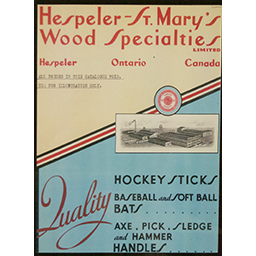
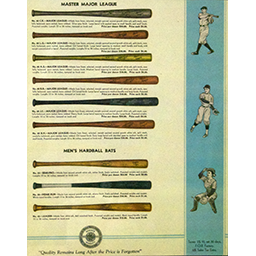
On January 7, 1935 the company changed its name to Hespeler-St.Mary’s Wood Specialties Ltd and its catalogue that year listed 20 hockey sticks models with new names like Mic Mac, Green Flash and Professional. St Mary’s lines included 10 high-grade hickory axe & sledge handles and 29 ball bat models in Professional “Superpower” baseball, softball and boys models. Top baseball bats were now bone rubbed and listed at $3.00 each with new sales agencies now in Vancouver BC. Gaining popularity, by 1938 the company was now known as the “world’s largest hockey stick manufacturers” . The company survived the depression and the outbreak of the war did not slow down business which thrived throughout this period. In 1947 Hespeler celebrated its Old Boys Town Re-Union from June 30 to July 6. An aerial photo of the factory appeared in the program along with a display of the many product lines the plant offered. The caption for the photograph carried the following information “Today this concern is turning out wood items to the tune of over 1,000,000 units per year. Some of its principle products are hickory striking tool handles such as axe, pick, sledge and hammer, the world famous lines of Hespeler hockey sticks and St. Marys baseball and softball bats. These products are shipped all over the world.” During the 1950’s the company phased out the tool products and concentrated on hockey sticks and baseball bats. At this time, with few competitors, Hespeler was considered one of the leaders in the industry celebrating its 50th anniversary in 1958. Sales representatives now included the Maritimes and Newfoundland with foreign representatives in the US, British Isles, Sweden, Holland, Belgium, Switzerland, Australia, New Zealand, South Africa, Mexico and Dominican Republic the bat “models” included Ted Williams, Mickey Mantle, Al Rosen, Eddie Mathews, Duke Snider, and Stan Musial. By 1972 the next chapter in the story was about to unfold. Jack Cooper worked in the personal and travel leather goods department at Eatons in 1928. He bought leather goods from a “transplanted Scot” R.H. Cameron who had founded General Leather Goods in 1905. Jack Cooper had long admired the quality of General’s leather products and expressed a desire to join the company which employed 15 people. He met Mr. Cameron in June 1932 and a week later was hired for $20/week, a dollar more than his previous salary. The company made some ski and snow shoe harness sets but were being affected by the depression. They began to make low priced hockey shin pads from $0.39 to $1.00 per pair, then all leather hockey gloves from $2.00/Pr to $4.00 for the pro models. In 1939 Jack Cooper and Cecil Weeks (a cousin of Mr. Cameron) were running most of the business which they purchased in 1946 when Mr. Cameron was 78 years old. The company became Cooper Weeks and was later famous as Canada’s leading manufacturer of leather protective hockey equipment and baseball gloves. It became Cooper of Canada on June 15, 1971. On July 5, 1972 Cooper purchased Hespeler-St. Mary’s Wood Specialties Ltd from the Seagram family, who still controlled the business through their Waterloo Woods Products Company. The name remained the same as Cooper operated the plant as the Hespeler -St. Mary’s Wood Specialties Division until 1979 when it became a part of Cooper Canada Ltd. Ball bat sales more than tripled over the next 10 years and a small moment in baseball history occurred in September 1985 when Tony Fernandez was the 1st Pro Player to use a Cooper Bat. Unfortunately for Cooper, the league hadn’t approved its use, so Fernandez went back to the dugout for a new bat. On March 27th, 1986 the Cooper bat was accepted by the Major League Playing Rules Committee for use in Major League baseball games. On April 11th, 1986 in a game against world-series champions, Kansas City Royals, Buck Martinez of the Toronto Blue Jays had his first hit of the season off a Cooper bat and this was the 1st Major League hit ever off a Canadian made bat. Tim Raines of the Montreal Expos won the 1986 NL Batting Championship using the newly introduced “Cooper” bat. Paul Molitor was also slamming a Cooper bat during his 39 game hitting streak in 1987. By 1988, after 3 short years, the company had grabbed 30% of the professional bat market. Cooper limited their sales to 130 players and 8500 bats/season, which was their maximum capacity at their Cambridge (Hespeler) plant. They remained #2 behind Louisville. Year after year, more and more major league stars like Kelly Gruber, Jesse Barfield, Cecil Fielder, Joe Carter and others put their faith in Cooper to deliver. By 1995 over 70,000 major league bats had been made for over 850 major league players in the last 10 years. According to Montreal Expos outfielder Hubie Brooks, in an article dated March 1989, “These bats (Cooper) are the best bats in the business. You know why they are so good…it’s the grain. The bats don’t break as often. People are going to be begging you for these bats soon.” In 1996 the Cooper line was discontinued at this plant. The corporate decision to transfer production to another location led to a decline from 130 to less than 5 Pro players in just one year. The Pro ball bat machinery in Cambridge started to gather sawdust drifting gently in from the Pro stick machines still running and gone were the days of watching 12 of 18 starters in a game using Cooper bats. This created the beginning of a vacuum of silence waiting for something to happen….. Special Note: Mr. Cooper or “the Chief” as he was affectionately called by his employees built his success for 55 years on high performance quality products, great service, strong research and development all combined with his personal integrity and dedication to his employees, suppliers and customers. He was elected to the Canadian Business Hall of Fame in 1989 an honor he truly deserved.
Los años de KR3
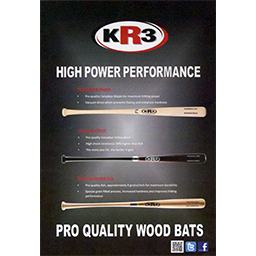
En la primavera de 1999, el silencio se rompió cuando Ross Huehn, director de la planta de Cooper durante mucho tiempo, decidió que era el momento de desempolvar la maquinaria y reiniciar la tradición. El Sr. Huehn comenzó a trabajar en Cooper el 19 de julio de 1973 como supervisor de envíos y recepciones, y fue ascendido a director de producción en 1974, a cargo del control de las existencias de hockey y bates de béisbol en dos almacenes canadienses y uno estadounidense, así como de la programación de la producción. Fue ascendido a Director de Planta en enero de 1976. Se compró toda la tienda Cooper Pro Shop, el personal principal como Frank Cavanaugh - Ball Bat Lead Hand, (Cooper 1976) y Dave Mather - Maintenance & Pro Bat Smith, (Cooper 1976) y los nuevos equipos se llevaron a una nueva ubicación en Kitchener, Ontario para comenzar el proceso de establecer la tercera generación en la fabricación de bates canadienses de St. El nuevo KR3 estaba ahora bajo la dirección de Rachel Huehn, que comenzó a trabajar en septiembre de 1999. Comenzó a reconstruir para las generaciones futuras una empresa canadiense con una amplia experiencia en la compra de madera de alta calidad, en la clasificación, en el torneado y en el acabado de los bates mediante antiguos procesos de endurecimiento, todo ello centrado en la fabricación de productos que superen los niveles profesionales más altos. Cuando KR3 comenzó a preparar la producción, el Sr. Huehn continuó trabajando a tiempo completo como Director de Planta en la planta de Hespeler para los actuales propietarios Bauer Nike Hockey, donde siempre se han seguido fabricando palos de hockey. Siempre existirá un agradecimiento especial a Bauer Nike por haber accedido a vender la parte de la empresa dedicada a los palos al Sr. Huehn a un valor de mercado justo para poder transmitir las tradiciones a la siguiente generación. A principios del año 2000, KR3 comenzó a vender bates a equipos independientes en los Estados Unidos y a fabricar para otras marcas conocidas. Marys, convirtiéndose en su proveedor exclusivo de bates y proporcionándoles todos los bates del Día de la Inducción cada año. KR3 fue aprobado y recibió su licencia de Grandes Ligas el 2 de febrero de 2001 y pasó el tiempo en 2001 y 2002 muestreando y trabajando con los jugadores de Grandes Ligas, mientras mantenía las puertas abiertas para los jugadores locales de la zona y al hacerlo se dio cuenta rápidamente de que los jugadores aficionados no tenían acceso a bates de madera de buena calidad. Así que empezamos a ofrecer la calidad de las Grandes Ligas a todos nuestros clientes y vimos cómo estos equipos empezaban a ganar campeonatos. Este momento era perfecto para nosotros, ya que cada vez más ligas se alejaban del aluminio y volvían al juego tradicional con madera. En 2003 firmamos un acuerdo para convertirnos en el proveedor oficial de bates de la Liga Canadiense de Béisbol. Apoyar el crecimiento del béisbol en Canadá siempre ha sido un objetivo principal para nosotros, así que estábamos muy interesados en participar. Lo que no ha cambiado desde que abrimos es nuestra perspectiva comercial. Siempre ofreceremos bates de béisbol de la más alta calidad a buenos precios y un excelente servicio a todos los jugadores de béisbol. Una verdadera tienda profesional para todos los jugadores de béisbol. KR3 fue aprobado para jugar en la MLB el 11 de enero de 2011. Durante los siguientes 3 años nos centramos en la venta de bates de madera maciza de calidad Pro. En 2014, decidimos ampliar nuestros bates de madera maciza de calidad Pro a todos los jugadores de pelota y hacer crecer nuestra línea de compuestos de madera en todo el mundo. Muchas noches y fines de semana han sido consumidos por nuestra familia terminando los bates a veces durante todo el día. "No importa cómo pase el tiempo, siempre recordaré los muchos fines de semana cuando empezamos, que pasé sumergiendo bates hasta bien entrada la noche junto a mi padre. Es un empresario honesto y trabajador y he aprendido mucho sobre los valores empresariales de antaño, que están disminuyendo en el mercado actual. KR3 siempre se regirá por estos valores", afirma Rachel Hamel. "Nuestros clientes vuelven cada temporada sabiendo que siempre haremos todo lo posible por ellos". Hay una diferencia asombrosa entre la madera de grado profesional y la de grado minorista, y muestra sus efectos en el juego. El regreso del "Pop" cuando un jugador batea con un bate de madera KR3 Pro trae de vuelta la diversión mientras rodea las bases para llegar a casa. Es tiempo de verano, barbacoas y buen tiempo con un viejo juego jugado de la forma en que se debe jugar.
Bates de alto rendimiento que le dan la libertad de golpear fuera del punto dulce sin romper el bate. Lo último en alto rendimiento.
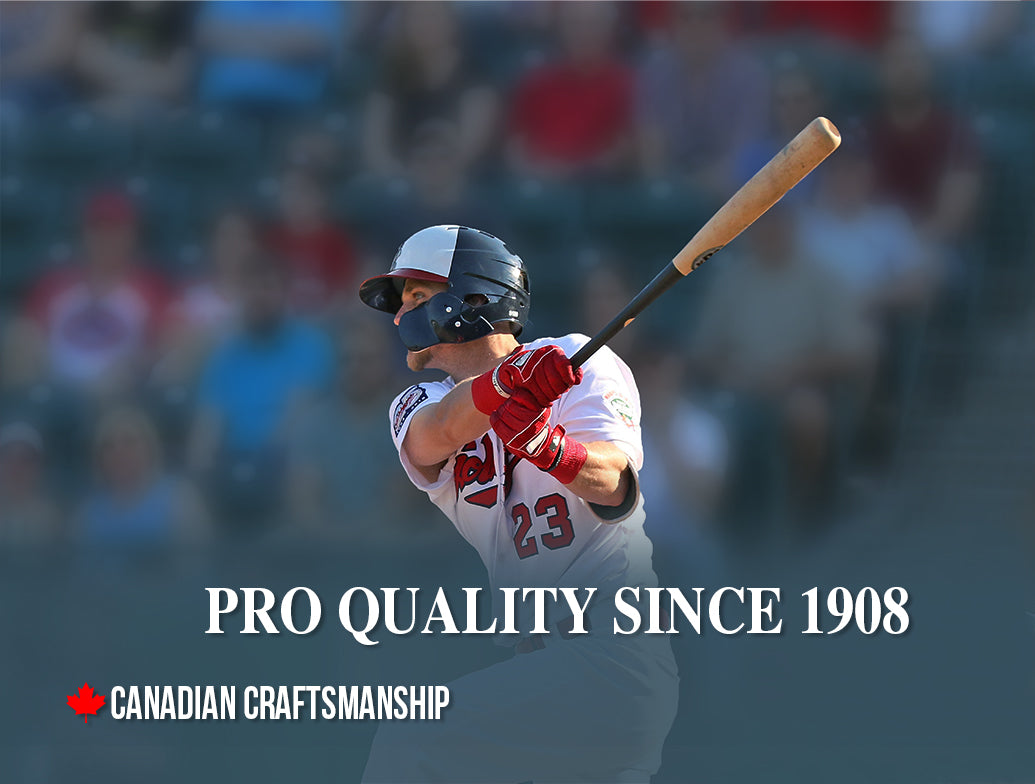
2003 - Lanzamiento Maple Magnum con 90 días de garantía y BBCOR
2004 - Launch Hickory Magnum con 6 meses de garantía y BBCOR La madera más dura del béisbol
2007 - Lanzamiento de Arce Fibre-Loc con 90 días de garantía y BBCOR
2010 - Lanzamiento de Birch Crossover en Drop 5 con 90 días de garantía
2012 - Lanzamiento Eagle Magnum con 60 días de garantía y BBCOR "Diseñado por el presidente con 40 años de fabricación de bates"
2016 - Lanzamiento Birch Crossover en Drop 7 con 90 días de garantía y BBCOR
2017 - Launch Eagle Magnum Ultra con 90 días de garantía y BBCOR. También Launch Maple Crossover con 90 días de garantía.
2019 - Launch Maple Magnum Ultra con 4 meses de garantía y BBCOR
2020 - Launch Maple Magnum con 6 meses de garantía y BBCOR. Lanzamiento Maple Magnum Serie Ultra Gold con 1 año de garantía y BBCOR
